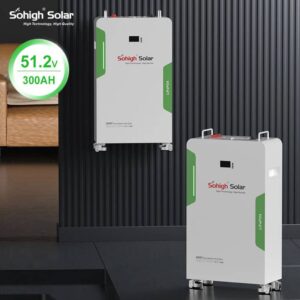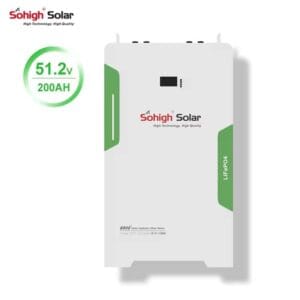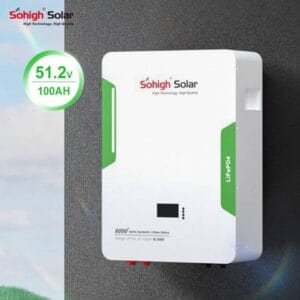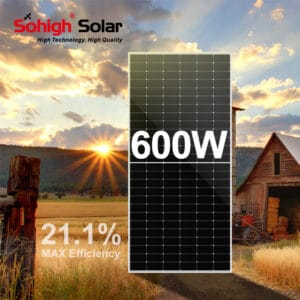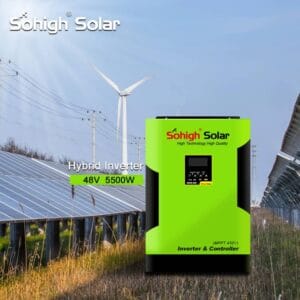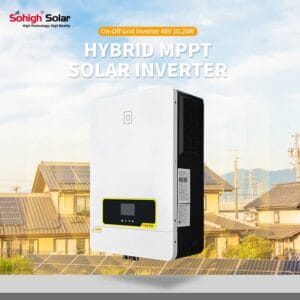Power(W): 7200W
Model: Sohigh On-Off Grid 8KVA
Brand: Sohigh Solar
Voltage(V): 48V
Product Origin: Guangzhou,China
Capacity: 160A
Digitalization and intelligent upgrade
In recent years, domestic and international mainstream PV inverter suppliers have coincidentally aimed at the intelligent IoT field, developing new intelligent software technology platforms one after another to create digital services and create new revenue sources.
The key function of an inverter is to convert solar energy into electrical energy for use in the power grid. In the past, solar inverters were considered to be independently decentralized and not connected to each other. However, in the new digital energy world, software platforms are unlocking once isolated and separated device components.
Many international solar inverter suppliers have developed their own proprietary in-house IoT software platforms to sell solar and energy storage hardware and digital services to commercial chains, large utilities and other non-traditional customers, and to extend their reach to thousands of independent homeowners.
Artificial intelligence technologies will also be gradually integrated into PV, including Smart IV technology, which is currently being used successfully on a large scale. PV systems will be digitally and intelligently enhanced with inverters as the core. While comprehensively improving the efficiency of power generation and operation and maintenance, it will create the ultimate platform for future integrated energy services.
The renewable energy industry’s reliance on artificial intelligence is mainly focused on sensor technology integrated in the battery. With the rapid development of sensor technology, renewable energy manufacturers expect to see more machine memory chip tools integrated into these systems to improve their ability to monitor, process and analyze daily tasks without disrupting the system. Solar power benefits from the fact that these technologies have only recently been commercialized and have had sensor technology installed from the beginning. As a result, most of the advances supported by artificial intelligence in solar development have focused on resource prediction, control and predictive maintenance.
| Power | 7.2KW | 8.2KW | 10.2KW | |
| Input Voltage Waveform | Sinusoidal (utility or generator) | |||
| Norminal Input Voltage | 230Vac | |||
| Low Loss Voltage | 170Vac±7V (UPS); 90Vac±7V (Appliances) | |||
| Low Loss Return Voltage | 170Vac±7V (UPS); 100Vac±7V (Appliances) | |||
| High Loss Voltage | 280Vac±7V | |||
| High Loss Return Voltage | 270Vac±7V | |||
| Max AC Input Voltage | 300Vac | |||
| Nominal Input Frequency | 50Hz / 60Hz (Auto detection) | |||
| Low Loss Frequency | 40±1HZ | |||
| Low Loss Return Frequency | 42±1HZ | |||
| High Loss Frequency | 65±1HZ | |||
| High Loss Return Frequency | 63±1HZ | |||
| Output Short Circuit Protection | Circuit Breaker | |||
| Efficiency (Line Mode) | >95% ( Rated R load, battery full charged ) | |||
| Transfer Time | 10ms typical (UPS); 20ms typical (Appliances) | |||
| Output Voltage Waveform | Pure Sine Wave | |||
| Output Voltage Regulation | 230Vac+ 5% | |||
| Output Frequency | 50HZ | |||
| Peak Efficiency | 93% | |||
| Overload Protection | 3s@≥150% load; 5s@101%~ 150% load | |||
| Surge Capacity | 2* rated power for 5 seconds | |||
| Nominal DC Input Voltage | 48Vdc | |||
| Cold Start Voltage | 46.0Vdc | |||
| Low DC Warning Voltage @ load ≤ 50% @ load≥50% | 44.0Vdc 42.0Vdc | |||
| Low DC Warning Return Voltage @ load ≤50% @ load≥50% | 45.0Vdc 44.0Vdc | |||
| Low DC Cut-off Voltage @ load ≤ 50% @ load≥50% | 41.0Vdc 40.0Vdc | |||
| High DC Recovery Voltage | 62Vdc | |||
| High DC Cut-off Voltage | 63Vdc | |||
| Storage Temperature | ‘-10℃ to 60℃ | |||
| No Load Power Consumption | 60W | 70W | 75W | |
| Maximum Second Load(battery model) | 2400W | 2733W | 3400W | |
| Main Load Cut Off Voltage | 44VDC | |||
| Main Load Return Voltage | 53.5VDC | |||
| Charging Algorithm | 3-Step | |||
| AC Charging Current (Max) | 140Amp | 140Amp | 160Amp | |
| Floating Charging Voltage | 54Vdc | |||
| Max. PV Array Power | 8200W | 10200W | ||
| Nominal PV Voltage | 360Vdc | |||
| PV Array MPPT Voltage Range | 90Vdc-500Vdc | |||
| Max. PV Array Open Circuit Voltage | 500Vdc | |||
| Max Charging Current (AC charger plus solar charger) | 160Amp | 160Amp | 180Amp | |
| Nominal Output Voltage | 220/230/240 VAC | |||
| Feed-in Grid Voltage Range | 195 ~ 253VAC | |||
| Feed-in Grid Frequency Range | 49~51士1Hz/59~61+1Hz 49~51士1Hz/59~61+1Hz | |||
| Nominal Output Current | 31.3A | 35.6A | 44.3A | |
| Power Factor Range | >0.99 | |||
| Maximum Conversion Efficiency (DC/AC) | 98% | |||
| Operating Temperature Range | -10°C to 50°C | |||
| Storage temperature | -15°C~ 60°C | |||
| Humidity | 5% to 95% Relative Humidity (Non-condensing) | |||

